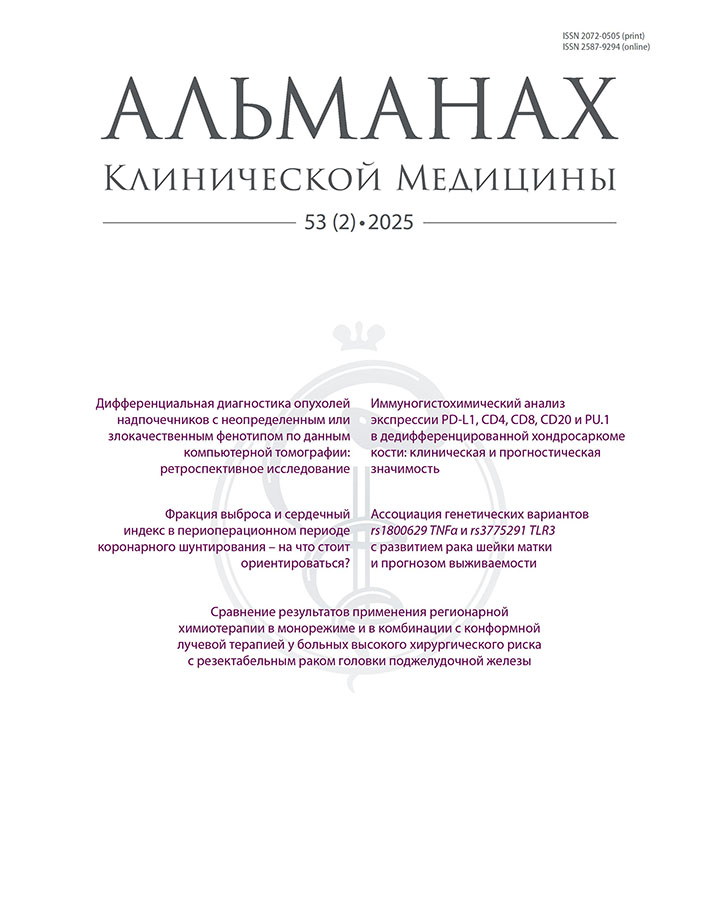ВЗАИМОСВЯЗЬ СЫВОРОТОЧНОГО ЛЕПТИНА И ПЛАЗМЕННОГО АПЕЛИНА У МУЖЧИН С МЕТАБОЛИЧЕСКИМ СИНДРОМОМ
- Авторы: Федотова А.В.1, Чернышева Е.Н.1, Панова Т.Н.1, Ахтямова К.В.1
-
Учреждения:
- ГБОУ ВПО «Астраханский государственный медицинский университет» Минздрава России
- Выпуск: Том 44, № 4 (2016)
- Страницы: 457-461
- Раздел: ОРИГИНАЛЬНЫЕ СТАТЬИ
- URL: https://almclinmed.ru/jour/article/view/435
- DOI: https://doi.org/10.18786/2072-0505-2016-44-4-457-461
- ID: 435
Цитировать
Полный текст
Аннотация
Актуальность. Метаболический синдром принято рассматривать как совокупность факторов повышенного сердечно-сосудистого риска. В патогенезе метаболического синдрома играют роль новые гормоноподобные субстанции – адипокины лептин и апелин, вырабатываемые жировой клетчаткой.
Цель – изучить апелин плазмы и лептин сыворотки крови у пациентов с метаболическим синдромом.
Материал и методы. Обследованы 122 мужчины с метаболическим синдромом и 30 практически здоровых мужчин в возрасте от 25 до 60 лет. Всем пациентам проводилось комплексное обследование для установления диагноза метаболического синдрома, а также исследование лептина сыворотки крови и апелина плазмы крови.
Результаты. Уровень сывороточного лептина был в 10 раз выше, а плазменного апелина в 3 раза выше у пациентов с метаболическим синдромом (n=122) по сравнению с контролем (n=30): 25,43 против 3,99 нг/мл (p<0,05) и 1,13 против 0,66 нг/мл (p<0,05) соответственно. Сывороточный лептин коррелировал со всеми показателями избыточной массы тела: с массой тела (r=0,79, р<0,05), индексом массы тела (r=0,93, р<0,05), окружностью талии (r=0,61, р<0,05), окружностью бедер (r=0,57, р<0,05), отношением окружности талии к окружности бедер (ОТ/ОБ; r=0,4, р<0,05). Плазменный апелин коррелировал с окружностью талии (r=0,27, р<0,05) и с индексом ОТ/ОБ (r=0,29, р<0,05). При разделении обследованных по индексу массы тела выявлено значительное нарастание сывороточного лептина по мере увеличения степени ожирения: с 19,8 нг/мл у больных с I степенью ожирения (n=49) до 28,7 нг/мл у пациентов со II степенью ожирения (n=46) (р<0,05), достоверного увеличения плазменного апелина не наблюдалось, но имелась соответствующая тенденция. При разделении пациентов с метаболическим синдромом по признаку абдоминального ожирения (ОТ/ОБ) уровень плазменного апелина вырос в 3 раза (с 0,36 у пациентов с индексом ОТ/ОБ менее 1 (n=35) до 1,09 нг/мл у пациентов с индексом ОТ/ОБ, равным 1 или более (n=87), р<0,05), сывороточный лептин нарастал незначительно. Взаимосвязи между плазменным апелином и сывороточным лептином у больных с метаболическим синдромом не установлено (r=0,1, р>0,05).
Заключение. Показатели адипокинов у пациентов с метаболическим синдромом выше, чем у здоровых. Уровень сывороточного лептина является чувствительным показателем, отражающим накопление жировой клетчатки и мало зависящим от места ее локализации. Плазменный апелин менее чувствительный показатель, но реагирует на увеличение жировых отложений именно центральной локализации.
Об авторах
А. В. Федотова
ГБОУ ВПО «Астраханский государственный медицинский университет» Минздрава России
Автор, ответственный за переписку.
Email: fedotova_alena_v@mail.ru
аспирант кафедры госпитальной терапии,
414056, г. Астрахань, ул. М. Максаковой, 39/10–69
414000, г. Астрахань, ул. Бакинская, 121
РоссияЕ. Н. Чернышева
ГБОУ ВПО «Астраханский государственный медицинский университет» Минздрава России
Email: fake@neicon.ru
д-р мед. наук, доцент кафедры госпитальной терапии,
414000, г. Астрахань, ул. Бакинская, 121
РоссияТ. Н. Панова
ГБОУ ВПО «Астраханский государственный медицинский университет» Минздрава России
Email: fake@neicon.ru
д-р мед. наук, профессор кафедры госпитальной терапии,
414000, г. Астрахань, ул. Бакинская, 121
РоссияК. В. Ахтямова
ГБОУ ВПО «Астраханский государственный медицинский университет» Минздрава России
Email: fake@neicon.ru
аспирант кафедры госпитальной терапии,
414000, г. Астрахань, ул. Бакинская, 121
РоссияСписок литературы
- Boucher J, Masri B, Daviaud D, Gesta S, Guigné C, Mazzucotelli A, Castan-Laurell I, Tack I, Knibiehler B, Carpéné C, Audigier Y, Saulnier-Blache JS, Valet P. Apelin, a newly identified adipokine up-regulated by insulin and obesity. Endocrinology. 2005;146(4):1764–71. doi: 10.1210/en.2004-1427.
- Szokodi I, Tavi P, Földes G, Voutilainen-Myllylä S, Ilves M, Tokola H, Pikkarainen S, Piuhola J, Rysä J, Tóth M, Ruskoaho H. Apelin, the novel endogenous ligand of the orphan receptor APJ, regulates cardiac contractility. Circ Res. 2002;91(5):434–40.
- Romantsova TI, Volkova GE. Leptin i grelin: antagonism i vzaimodeystvie v regulyatsii energeticheskogo obmena [Leptin and ghrelin: their antagonism and interplay in the regulation of energy turnover]. Ozhirenie i metabolizm [Obesity and Metabolism]. 2005;(2):2–9 (in Russian).
- Yue P, Jin H, Xu S, Aillaud M, Deng AC, Azuma J, Kundu RK, Reaven GM, Quertermous T, Tsao PS. Apelin decreases lipolysis via G(q), G(i), and AMPK-Dependent Mechanisms. Endocrinology. 2011;152(1):59–68. doi: 10.1210/en.2010-0576.
- Chazova IE, Mychka VB, Kislyak OA, Kuznetsova IV, Litvin AYu, Shestakova MV, Bugrova SA, Zvenigorodskaya LA, Koshel'skaya OA, Kukharchuk VV, Mamedov MN, Medvedeva IV, Mkrtumyan AM, Nebieridze DV, Nedogoda SV, Perepech' NB, Podzolkov VI, Simonova GI, Titov VN, Tyurina TV, Fursov AN, Khirmanov VN, Chukaeva II, Shal'nova SA, Shubina AT. Diagnostika i lechenie metabolicheskogo sindroma. Rossiyskie rekomendatsii (vtoroy peresmotr) [The diagnosis and treatment of the metabolic syndrome. The Russian guidelines, 2nd review]. Kardiovaskulyarnaya terapiya i profilaktika [Cardiovascular Therapy and Prevention]. 2009;8(6 Suppl 2):1–29 (in Russian).
Дополнительные файлы








